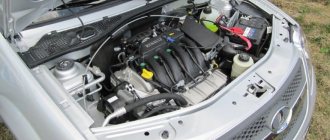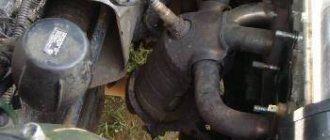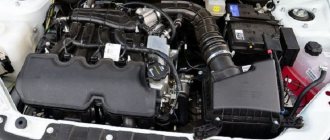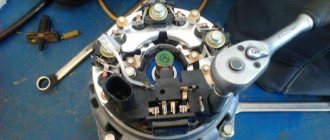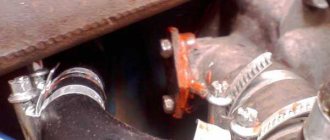This question is not often, but consistently asked by my readers and channel viewers - what is better than 8 or 16 valves in the engine block head? Many people believe that the 8-valve version is a thing of the past and spending your hard-earned money on it is, at the very least, stupid! But 16 is YES, IT IS! Others, on the contrary, insist that the 16 valve version is more expensive, more demanding to maintain, and if it breaks, “write it down”! But where is the truth, and what exactly is the difference between these two units, are they very different? I propose to weigh all the pros and cons, so there will be a video version...
You know, there are really a lot of battles on the Internet on this never-ending topic, but I think everyone here is right in their own way. After all, some expect reliability and simplicity, while others expect greater power and smooth operation. The tasks are different, and the engines are different, but let's take a closer look.
About the technical component
Technically, engines with 8 and 16 valves are quite different. Although all the difference is stored at the top (engine block head) where the car's camshafts (camshaft) are/are installed. In fact, this is the main design feature, but what I want to note is that almost every engine can be made into either an 8 or 16 valve version. For example, on our VAZs, the engines are very similar, and hypothetically, on the same block, you can fit a different cylinder head, with one or two camshafts.
Consumer characteristics
In addition to power and efficiency, the engine is evaluated in terms of repair and maintenance costs. The ability to improve the performance of the motor also increases its “value”. For example, to increase the engine displacement, the cylinders are bored or the piston stroke is increased.
Repair work
Any engine experiences high load during aggressive driving. Whether it's an 8 or 16 valve engine. Even with proper operation, the power unit has resource limitations. Many of the parts involved wear out and need to be replaced. Frequent problems:
- floating or high idle speed. During diagnostics, the mass air flow sensors, idle air control and throttle valve are checked;
- overheating of the engine may be due to a faulty thermostat, lack of coolant or contamination of the radiator;
- clogged injectors or old spark plugs can cause engine vibration;
- Electrical failures often occur on domestic engines;
- knocking noises under the hood indicate faulty hydraulic lifters, unadjusted pushers or a damaged connecting rod and piston group.
If the engine is equipped with push-in pistons, without grooves on the bottom, a broken timing belt causes the valve stems to bend. To avoid the problem, you need to install a high-quality belt and check its condition every 15,000 km. A safer option is to replace the pistons with non-stick ones.
A drop in compression or an increased appetite for oil is already a reason for a major overhaul, but in practice this happens after 200,000 km. The difference in the cost of major repairs of 8 and 16 valve VAZ engines is 5 - 10 thousand rubles. The average price for a complete overhaul is 8kl. — 35,000 rub.
Similar article Technical characteristics of the GAZ ZMZ 21 engine
Tuning
Engines are tuned to achieve better performance, both 8 and 16 valve units. To achieve high-torque performance of the car, the engine displacement is “increased”:
- Bore the cylinders or increase their number.
- Increase piston stroke.
The most popular method is cylinder boring. However, cutting more than 3 mm from the original size may result in thinning of the walls. This reduces the service life of the part and leads to leaks.
Other tuning options:
- Increasing the number of valves.
- Installation of a sports camshaft for increased power and efficiency.
- Increasing the volume of the exhaust receiver to stabilize the engine.
- Replacing the air filter with a zero filter to increase the amount of incoming air.
- Turbocharged engine.
Main differences.
The 8-valve engine has a narrow cylinder head because it has a single camshaft. The candles are located on the block horizontally and at a certain angle. The camshaft controls the order of their opening - first it opens the intake, then the exhaust. The valve opens with the help of conical parts located on the camshaft, and closes with the help of springs located on it. In a four-cylinder engine, there are two valves for each cylinder of the engine - intake and exhaust. Actually, that’s why there are eight of them per power unit.
In a 16-valve engine, the cylinder head is wide in relation to the single-row four-cylinder block, since there are two camshafts on it. The design itself is complicated; the valves are adjusted using hydraulic compensators. Opening and closing have the same principle as in an 8-valve engine. The spark plugs in such engines are positioned strictly vertically, as if buried in the cylinder block cover. For each one engine cylinder there are already 4 valves - which means, respectively, 16 per engine. What if, instead of two small valves, we insert two larger valves... In principle, it is possible, but then the gas will fill the combustion chamber unevenly, and the engine will not operate as silently as we would like.
Advantages of an 8-valve engine:
- Initially, the design of the engine is relatively very simple and, accordingly, easy to maintain.
- The absence of hydraulic compensators undoubtedly simplifies the design of the power plant as a whole.
- Undemanding to oil.
Flaws:
- Power is less compared to a 16 valve engine. It is also impossible to achieve such high speeds - two valves per cylinder does not allow speeding up the intake and release of fuel and gases from the chamber. The process is happening slower than we would like.
- Increased fuel consumption. Due to the fact that the gas exits through one valve, which cannot let through more than it should.
- Such engines are, in essence, noisier, especially when moving at high speeds.
- The absence of hydraulic compensators requires adjustment of the valves as their precise synchronization is disrupted (even with slight deformation of the camshaft cam profile), in the worst case, a knocking sound appears.
16-valve engine and its significant advantages:
- More powerful. It accelerates better and therefore the top speed will be significantly higher than that of an 8-valve engine. More powerful. Accelerates better and therefore the top speed will be significantly higher than the 8-valve engine.
- It is also important that fuel consumption is noticeably less (should be).
- Engine noise is less.
- The valves are regulated by hydraulic compensators.
Flaws:
- The presence of hydraulic compensators requires a timely change of engine oil to avoid coking of the hydraulic compensators.
- Engine maintenance is more expensive. After all, the design of such an engine is an order of magnitude more complex than the design of an 8-valve engine.
A few words about another reason why valves should sit tightly in the seat. In addition to ensuring complete sealing of the combustion chamber, it should be taken into account that the valve discs operate under severe conditions of high heat. In addition, the plates must be in close contact with the seat, which is located on the cylinder head, which is cooled. After all, the heated plate transfers most of the heat to the saddle. This is especially true for the exhaust valve, since it is cooled only through the tight fit of the plate to the seat, and the intake valve is cooled when the incoming air-fuel mixture is in contact with the seat. If there is poor contact with the seat, no (even the most heat-resistant) valve will withstand such strong overheating. It will simply burn out and collapse, so its tight fit in the saddle is very important. Therefore, they are made from heat-resistant metal alloys. In addition, they do not have magnetic properties.
The birth of the “gear”: how 16-valve VAZ engines survived to this day
Trends of the times
Using the unit base and the G8 platform for the new model, Tolyatti understood that by the time mass production of the VAZ-2110 started, the “eighth” engine would inevitably become obsolete.
After all, since the beginning of the eighties, environmental requirements in the world have become more stringent, and the liter capacity has constantly increased. The “charged” modifications of the Volkswagen Golf MKII and Opel Kadett E were practically twice as powerful as the basic versions (and the domestic Samara!), because their engines produced 130-140 “horses”! In addition, it became clear that the engine should not only be more powerful and environmentally friendly, but also more economical than its predecessor. Articles / History Ours took: how and why the VAZ-2101 received an overhead engine In the mid-sixties, an epochal event took place in the USSR - the construction of a new automobile plant began to produce a licensed version of the Fiat 124. Contrary to popular belief, “Russian... 25041 3 18 02/11/2018
This could be achieved in several ways. Firstly, VAZ unconditionally accepted the transition to a more modern distributed injection , which theoretically made it possible to comply with any emissions cleanliness standards that were relevant at that time.
Secondly, it was necessary to increase the liter power in order to increase the number of “horses” under the hood, while remaining at the same working volume. After all, not in all countries of the world buyers welcomed “large” engines due to taxes. Yes, and NAMI strictly defined the “liter range” of Soviet technology - VAZs had to fit into the range of 1.2-1.6 liters.
At that time, two ways to “cheer up” had already been tested in practice in the world - installing a turbocharger or switching to a multi-valve cylinder head, where the number of intake and exhaust valves for each cylinder was doubled. Having weighed all the pros and cons, VAZ settled on the second option, since supercharging would require much greater costs and technological innovations, while the scheme with four valves per cylinder was otherwise (“lower”) not much different from eight-valve engine, and due to better filling of the cylinders, the power and torque indicators, all other things being equal, should have increased by 10-15%. This means that, coupled with the “injector”, it was actually possible to extract at least 90 hp from a one and a half liter engine.
Porsche again
Having no personal experience in designing such structures, the VAZ team turned to Porsche specialists “out of old memory.” In addition, the Soviet side needed help from the Germans in aerodynamically fine-tuning the body of the “tens” . The contract signed in 1987 included both aerodynamic work and the development of a 16-valve engine with multipoint injection. At the same time, the working volume remained the same - 1.5 liters.
However, VAZ did not sit idly by, shifting the work of developing a new engine onto the shoulders and hands of German “specialists”! Under the leadership of A. Simulman, a version of a multi-valve block head with cast spark plug wells was assembled - that is, without insert parts.
The design of the 16-valve cylinder head was born in close cooperation with foreign specialists and at the same time turned out to be completely original
The option proposed by Porsche was less technologically advanced - in particular, it required a very complex shaped head gasket, the production of a mold for which Soviet rubber goods specialists simply did not undertake. But the German company Elring, which VAZ specialists contacted, agreed to do everything in four months and 400,000 German marks! Both the first and the second did not suit VAZ at all, so they had to... develop the design using VAZ’s own RTI STC, for which one month and 1,500 rubles were enough.
However, in the future, Porsche specialists had to involve little-known and highly specialized companies from Austria and Italy in the technological development and fine-tuning of the head casting. At the same time, the spark plug wells on early 16-valve engines were plug-in, and starting from the 124th engine they became cast, as originally planned in Tolyatti.
Cylinder head of VAZ-2112 engine
The sixteen-valve head required a serious modernization of the “eight” engine, which, at the request of VAZ, became a kind of blank for the “gear”.
In addition to the sixteen-valve design itself with two camshafts, the 2112 engine was also distinguished by the presence of hydraulic pushers with automatic adjustment of the thermal gap, because only compact “hydrics” made it possible to place another shaft and eight additional valves in the cylinder head. In addition to the gas distribution mechanism, the “twelfth” engine also received original intake and exhaust.
Despite the layout similarity with the 8-valve VAZ-21083 engine, the “top” of the new engine received two camshafts, 16 valves and a number of fundamental differences
The intake manifold on the 16-valve was separated from the exhaust. Initially, the intake was made of light alloy, but on the 1.6-liter engine it became plastic
Porsche specialists immediately doubted whether the block and crankshaft of the former eight-valve engine would be suitable for the new engine - after all, the loads, taking into account the increased power and torque, would inevitably increase. Special bench tests of the VAZ-21083 engine in Germany confirmed that its design and mechanical strength fully allow such “tuning”, but subsequently, to be on the safe side, the counterweights on the crankshaft for injection engines were slightly increased, and when the engine was converted into a 16-valve engine, the block received an important modification: Additional oil channels with nozzles pressed into them appeared in the main bearing supports, thanks to which the piston bottoms are washed with oil under pressure.
The German side also developed and optimized the shape of the combustion chamber, thanks to which, even taking into account the high compression ratio (10.5) on gasoline with an OC of 91-95, the VAZ-2112 engine operated without detonation.
In the early stages of fine-tuning the 16-valve engine, distributed injection components from the German company Bosch, familiar to Porsche specialists, were used, but later (since 1990) the Soviet side began to actively cooperate with the American company GM, switching to the “Gim” system not only for multi-valve engines, but also on conventional eight-valve engines of both the “eighth” and “classic” families. The irony of fate was that five years later VAZ again returned to Bosch injection components on its engines, ceasing cooperation with GM in this direction.
Long labor, short life
For the first time, the “ten” with a new engine was officially demonstrated at the end of 1992 at the Moscow Manege, and in 1994, AvtoVAZ “showed off” a pre-production prototype of the VAZ-2110 at the Paris Motor Show.
The “Ten” with a sixteen-valve engine became a real star of the March 1993 Za Rulem magazine: in addition to the cover, the bright new product was given four first pages
16 valves - so it will be in Russian
As it turned out, under the large plastic cover with the “foreign” inscription “16 VALVE” was hidden exactly the 16-valve VAZ-2112 engine, which developed 94 hp. at 5,600 rpm. At the same time, the engine turned out to be quite high-torque - it produced 130 Nm already at 3,600 rpm. Thus, the liter power of the new engine was 62 hp. - not the worst indicator by the standards of the early nineties. At least, European and Japanese analogues with a similar engine design developed approximately 65-70 hp. per liter of working volume.
The speedometer doesn’t lie: with a 16-valve valve, the new VAZ model is very close to the 200 mark – especially according to the speedometer. To be precise, the “one hundred and third”, according to the manufacturer, accelerated to 185 km/h
The VAZ-2112 engine was combined with ventilated front brakes and a reinforced transmission
The more powerful engine required strengthening of transmission parts - in particular, the use of a new secondary shaft with increased rigidity, as well as an increase in clutch diameter from 190 to 200 mm.
The 16-valve engine in the top ten, unlike Samara, was already laid out at the layout design level
The production of the VAZ-2110 was planned since 1995 - the first “tens” were assembled at the AvtoVAZ production plant on June 27, but full-scale mass production began only in 1996. At the same time, many of the first “living” cars were equipped not with a newfangled “gear”, but with a banal carburetor (!) engine with the index 2110.
Prototypes and pre-production samples of the VAZ-2110 looked different from commercial vehicles
And the “one hundred and third” (VAZ-21103) with the same one and a half liter 16-valve VAZ-2112 hit the main assembly line only in 2001.
Theoretically, the 16-valve VAZ could fuel the interest of foreign buyers in products from Tolyatti. In practice, the powerful “ten” seriously interested only the domestic consumer
It was planned that the 16-valve engine would also have a “chisel” - sort of a belated response from AvtoVAZ to the Volkswagen Golf GTI.
However, it later became clear that installing this engine under the hood of Samara required modifications to the body that were incompatible with large-scale production, so this idea was later abandoned, and the 16-valve VAZ-2112 engine remained the prerogative of the “tenth” family.
However, 16-valve engines under the hood of Samar still “leaked”: Tolyatti JSC “Super-Avto” produced VAZ-2113 and VAZ-2114 in “improved configuration”, which included 1.6-liter engines (21124 and 21126) with four valves per cylinder. Almost 100 forces allowed the “super-chisels” not only to compete on an equal footing with the rest of the VAZ sixteen-valve engines, but also to engage in traffic light races with budget foreign cars.
1 / 5
2 / 5
3 / 5
4 / 5
5 / 5
The one and a half liter sixteen-valve engine with index 2112 is easily distinguished by the light color of the intake manifold peeking out from under the plastic cover
However, the “pure twelfth” engine did not last on the assembly line for so long - less than five years, which is especially surprising for VAZ with its long-lived engines. It’s just that in the future, the designers decided to increase the working volume of both the eight- and sixteen-valve “ten” engines to 1.6 liters, which was achieved by installing a higher cylinder block and increasing the piston stroke from 71 mm to 75.6 mm. The new 16-valve engine received the index 21124 - it is popularly known as the “124th engine”. Its important difference from the first sixteen-valve VAZ is the “plug-in piston”: that is, when the timing belt breaks, the valves no longer meet the pistons. Interestingly, the 1,300 cc V8 engine developed by the Germans was also plug-in, but with an increase in displacement to 1.5 liters, this drawback was eliminated on the eight-valve versions (21083/2111).
The 124th engine differed from the first sixteen-valve engine in its increased displacement. Visually, the motor is easy to distinguish by its plastic intake module
An increase of 100 cubic meters of working volume made it possible not only to correct this design feature of the VAZ-2112 engine, but also to painlessly switch to Euro-3 standards without a noticeable deterioration in maximum power and torque.
Immortal "shesnari"
Subsequently, the sixteen-valve engine, along with the eight-valve 21114, was also used on Kalina , since all these front-wheel drive Ladas were created on a common platform .
Like the “ten”, in ten conveyor years Kalina managed to try on two “gears” of different sizes
But the story didn’t end there! the Priora VAZ-2170, released in 2007, the 16-valve engine was once again modernized using a new lightweight connecting rod and piston group from Federal Mogul.
1 / 4
2 / 4
3 / 4
4 / 4
The real “maximum speed” of the 16-valve Priora is 183 km/h
Because of this, the 124th and 126th engines differed in cylinder processing technology, as well as in the design of the head itself, which was associated with the use of a new timing belt tensioning mechanism from Gates. AvtoVAZ declared a maximum power of 98 hp for this engine, although during unofficial bench tests of the “one hundred and twenty-sixth” it was found that in practice it produces more - 102-107 “horses”. By the way, this is exactly how much the current 1.6-liter 16-valve engine with index 21127, which is structurally different from its predecessor, is officially developing for the Priora, Kalina and Granta, which is structurally different from its predecessor with a controlled air intake system.
In the same 2007, the sixteen-valve engine range was replenished with another option - the 1.4-liter engine 11194.
1.4-liter 16-valve VAZ-11194
Structurally, it had much in common with the 126th engine - in particular, the same lightweight piston group, but due to the cylinder diameter reduced to 76.5 mm, the working volume decreased to 1.4 liters, and the maximum power - to 89 hp. With. “Downsizing” of the Kalina engine was done with the aim of improving the fuel efficiency of the car, which, although it shared a platform with the “ten” and Priora, formally still belonged to a slightly lower class, as indicated by the model index, which began with the number 1, and not 2, as the rest have front-wheel drive. In practice, it turned out that the 1.4-liter engine has no noticeable consumer advantages over a conventional eight-valve engine.
Eight-valve alternative: along with the 16-valve, both the “ten”, Kalina, and Priora were also equipped with conventional engines with two valves per cylinder
Alas, both of these engines again received a “plug-in” piston group - that is, a design feature characteristic of the first 16-valve VAZ-2112. However, we must admit that by the standards of its time, this engine turned out to be no less successful than the eight-valve engine of the 2108 family, thanks to which the latest Lada models like Vesta, with a displacement increased to 1.8 liters, still drive with direct engine compartment heirs of that very “gear” "
Survey
What do you think is the secret to the longevity of these engines?
Your voice
Total votes:
8 valve engine
This is indeed an archaic, but nevertheless reliable, simple and cheap to repair scheme. New cars with such an engine are somewhat cheaper, but are practically not inferior to 16-valve cars either in dynamic characteristics or in fuel consumption. Regular maintenance of such machines is cheaper. Most 8-valve engines have “stickless” pistons, that is, if the timing belt breaks, the piston will not meet the valve. Such engines are not demanding on the quality of motor oil and can easily run on 92-grade gasoline.
The disadvantages include low power; in comparison with a 16-valve engine, it is 10–15% lower. This happens due to the inability to spin the engine more, because the intake and exhaust are slower. 8-valve engines are quite noisy due to mechanical pushers rather than hydraulic compensators, but this is also a plus.
Economical
In terms of fuel consumption, a 16-valve engine differs from an 8-valve engine by being slightly more economical. Multi-valve heads fill and distribute the mixture better due to the versatile filling of the chamber. This design feature ensures economical operation. In addition, fast acceleration allows you to save fuel, which is consumed at high speeds.
In practice, consumption depends on driving style, type of fuel, tire pressure, curb weight and outside temperature.
Despite being economical in terms of fuel consumption, the 16 valve engine requires better oil and gasoline. If in an 8 valve you can get by with semi-synthetics or mineral water, in a 16 valve it is permissible to use only synthetics.
Similar article CDI engine from Mercedes
16 valve engine
Such engines are more powerful, more flexible and quieter than their 8-valve counterparts. They allow you to more finely tune the operation of the timing belt, which affects the smoothness of the engine and the environment. It does not require periodic adjustment of the valves, since it is equipped with hydraulic compensators. The advantages also include a wide field for tuning, including installation of a turbine.
This engine also has a lot of disadvantages and, probably, more than the 8-valve engine: expensive repairs, because there are only two; high requirements for the quality of motor oil. It is recommended to use the more expensive 95 gasoline. If we are talking about VAZ engines, then their 16-valve engines traditionally suffer from oil leaks, since their cylinder head consists of three parts.
For the buyer of a new car, a similar choice will arise if he chooses something from AvtoVAZ or Renault. Most brands have not offered alternatives to 16-valve engines for a long time, the reason for this is high environmental requirements. When buying a used car. You can safely buy a car with an 8-valve engine; it is simple, cheap and unpretentious in operation, and also tolerates the transition from gasoline to gas well. Cars with 16-valve engines are more pleasant to drive, but more expensive to maintain.
